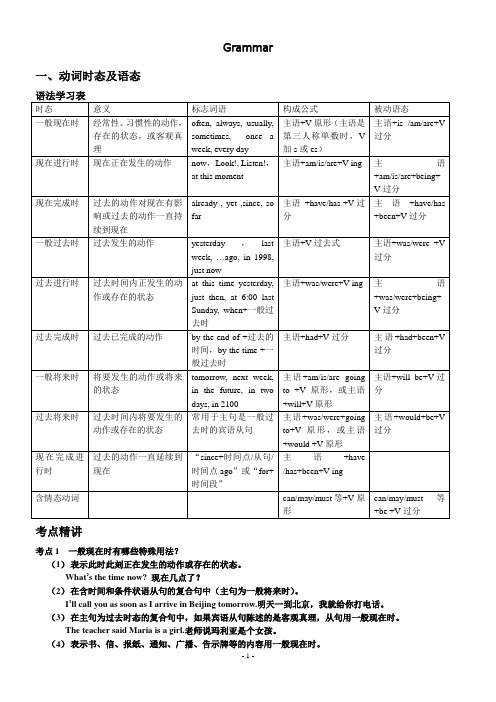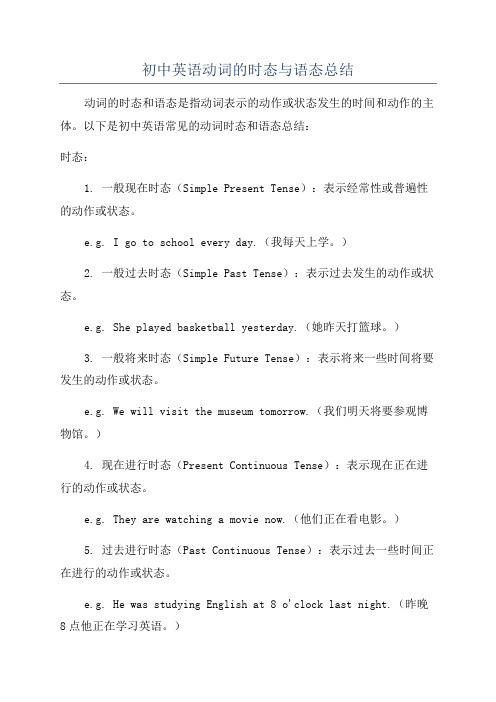初中英语动词时态和语态讲解
初中英语的动词各种时态、语态(80张)

一般现在时的谓语构成: 1、be动词:am/is/are 2、行为动词:
A:动词原形 B:动词+-s在时
am is are are ...
I am ... he/she/it is ... we/you/they
动 单词 数第 变三 化人
称
+s
write – writes
13.The new teachers arrive (arrive) tomorrow. 14.I will have arrived (arrive) by the time the
meeting begins (begin). 15.I will tell (tell) him the news as soon as I
3. If it d_o_e_s_n_’_t_r_a_in_ (not rain) tomorrow, we’ll go to the zoo.
4. Don’t get off the bus until it_st_o(psstop). 5. You may go out to play when you
实战演练
1.Jim usually h_a_s_(have) lunch at home, but sometimes he __h_a_s_ (have) it at school.
2.I’ll tell him the news as soon as he c_o_m__e_s(come) back.
come to our party, my family will be (be)
pleased.
5、表示安排或计划好的将来动作,通 常限于表示"运动"的动词,如:go, come, leave, start等。
初中英语动词时态及语态

Grammar一、动词时态及语态语法学习表时态意义标志词语构成公式被动语态一般现在时经常性、习惯性的动作,存在的状态,或客观真理often, always, usually,sometimes, once aweek, every day主语+V原形(主语是第三人称单数时,V加s或es)主语+is /am/are+V过分现在进行时现在正在发生的动作now,Look!, Listen!,at this moment 主语+am/is/are+V-ing 主语+am/is/are+being+V过分现在完成时过去的动作对现在有影响或过去的动作一直持续到现在already , yet ,since, sofar主语+have/has +V过分主语+have/has+been+V过分一般过去时过去发生的动作yesterday ,lastweek, …ago, in 1998,just now 主语+V过去式主语+was/were +V过分过去进行时过去时间内正发生的动作或存在的状态at this time yesterday,just then, at 6:00 lastSunday, when+一般过去时主语+was/were+V-ing 主语+was/were+being+V过分过去完成时过去已完成的动作by the end of +过去的时间,by the time +一般过去时主语+had+V过分主语+had+been+V过分一般将来时将要发生的动作或将来的状态tomorrow, next week,in the future, in twodays, in 2100主语+am/is/are goingto +V原形,或主语+will+V原形主语+will be+V过分过去将来时过去时间内将要发生的动作或存在的状态常用于主句是一般过去时的宾语从句主语+was/were+goingto+V原形,或主语+would +V原形主语+would+be+V过分现在完成进行时过去的动作一直延续到现在“since+时间点/从句/时间点ago”或“for+时间段”主语+have/has+been+V-ing含情态动词can/may/must等+V原形can/may/must等+be +V过分考点精讲考点1 一般现在时有哪些特殊用法?(1)表示此时此刻正在发生的动作或存在的状态。
初中英语语态时态

• 2.Dear me! Just ________ at the time! I _______ve B.looking;had • C.look;had D.looking;have
• 答案:C • 解析:第一空应填 look, 因为这是祈使句的 谓语;第二空应填 had,因为前一句说“看 看时间吧”,这一看当然知道了现在很迟 的情形,“不知道这么迟了”显然应是 “过去”的事,故应用一般过去时态。
• 答案:D • 解析:这是由 but I don’t know whether he has finished it 这一句话的语境决定的,全句意为“史 密斯先生去年在写一本书,但我不知道他现在是 否写完了”。有的同学可能由于受 last year的影响 而误选B。但若选B,则句子前半部分的意思则变 为“史密斯先生去年写了一本书”,既然是“写 了”,那么这与下文的“但我不知道他现在是否 写完了”相矛盾。
• 答案:C • 解析:考查时间状语从句中的时态和逻辑。 当before用在It (will) be +一段时间+before 从句这一结构中时,翻译成“要不了/没有 多久就会”,本题就是这个结构,主句是 将来时,before从句中应该是一般现在时表 示将来时
• • • • • • •
答案 1—5 6—10 11—15 16—20 21—25 26---30
CDCBC DDBBC DCCDA BDADC BCBAB CCAAA
• • • • •
II 1. comes 2. bought 3. was sent 4. watering 5. serving 6. would return 7. to help 8. Is, made 9. had finished 10. been awarded
初中英语知识点归纳动词的不同时态与语态

初中英语知识点归纳动词的不同时态与语态动词的不同时态与语态是初中英语的重要知识点。
掌握了动词的时态和语态,我们就能更准确地表达过去、现在和将来的动作,以及主语对动作的不同态度。
下面是对初中英语中动词的不同时态与语态的归纳总结。
一、动词的时态1. 一般现在时一般现在时表示经常性或习惯性的动作、客观真理、固定事件等。
例句:- I go to school every day.(我每天去上学。
)- The sun rises in the east.(太阳从东方升起。
)2. 现在进行时现在进行时表示现在正在进行的动作。
例句:- He is watching TV now.(他正在看电视。
)- They are playing basketball in the park.(他们正在公园里打篮球。
)3. 一般过去时一般过去时表示过去发生的动作或存在的状态。
例句:- We watched a movie last night.(昨晚我们看了一场电影。
)- She lived in Beijing when she was young.(她年轻时住在北京。
)4. 过去进行时过去进行时表示过去某个时间正在进行的动作。
例句:- They were having dinner at 7 o'clock yesterday.(昨天7点他们正在吃晚饭。
)- At this time last year, I was studying in London.(去年这个时间,我正在伦敦学习。
)5. 将来时将来时表示将要发生的动作或存在的状态。
例句:- We will go to the beach next week.(下周我们将去海滩。
)- She is going to visit her grandparents tomorrow.(她明天将要去看望她的祖父母。
)二、动词的语态1. 主动语态主动语态表示主语是动作的执行者。
初中英语动词的时态与语态总结

初中英语动词的时态与语态总结动词的时态和语态是指动词表示的动作或状态发生的时间和动作的主体。
以下是初中英语常见的动词时态和语态总结:时态:1. 一般现在时态(Simple Present Tense):表示经常性或普遍性的动作或状态。
e.g. I go to school every day.(我每天上学。
)2. 一般过去时态(Simple Past Tense):表示过去发生的动作或状态。
e.g. She played basketball yesterday.(她昨天打篮球。
)3. 一般将来时态(Simple Future Tense):表示将来一些时间将要发生的动作或状态。
e.g. We will visit the museum tomorrow.(我们明天将要参观博物馆。
)4. 现在进行时态(Present Continuous Tense):表示现在正在进行的动作或状态。
e.g. They are watching a movie now.(他们正在看电影。
)5. 过去进行时态(Past Continuous Tense):表示过去一些时间正在进行的动作或状态。
e.g. He was studying English at 8 o'clock last night.(昨晚8点他正在学习英语。
)6. 将来进行时态(Future Continuous Tense):表示将来一些时间正在进行的动作或状态。
e.g. They will be playing soccer at 4 pm tomorrow.(他们明天下午4点将正在踢足球。
)7. 现在完成时态(Present Perfect Tense):表示过去一些时间开始的动作一直持续到现在,或者与现在有关系的过去动作或状态。
e.g. I have lived in this city for 10 years.(我在这个城市住了10年了。
初中英语九大时态总结

一、一般现在时:概念:经常、反复发生的动作或行为及现在的某种状况。
时间状语:often,usually,always,sometimes,every week(day,year,month...),once a week,on Sundays,etc.基本结构:①be动词;②行为动词否定形式:①am /is /are +not;②此时态的谓语动词若为行为动词,则在其前加don't,如主语为第三人称单数,则用doesn't,同时还原行为动词。
一般疑问句:①把be动词放于句首;②用助动词do提问,如主语为第三人称单数,则用does,同时,还原行为动词。
二、一般过去时:概念:过去某个时间里发生的动作或状态;过去习惯性、经常性的动作、行为。
时间状语:ago,yesterday,the day before yesterday,last week(year,night,month...),in 1989,just now,at the age of 5,one day,long long ago,once upon a time,etc.基本结构:①be动词;②行为动词否定形式:①was/were +not;②在行为动词前加didn't,同时还原行为动词。
一般疑问句:①was或were放在句首;②用助动词do的过去式did提问,同时还原行为动词。
三、现在进行时:概念:表示现阶段或说话时正在进行的动作及行为。
时间状语:now,at this time,these days,etc.基本结构:am/is/are +doing否定形式:am/is/are +not+doing一般疑问句:把be动词放在句首四、过去进行时:概念:表示过去某段时间或某一时刻正在发生或进行的行为或动作时间状语:at this time yesterday,at that time或以when引导的谓语动词是一般过去时的时间状语等。
初中英语时态与语态考点整理

初中英语时态与语态考点整理一、协议关键信息1、一般现在时定义:表示经常发生的动作、存在的状态或习惯性的动作。
构成:主语+动词原形(当主语为第三人称单数时,动词加 s 或es)时间状语:always, usually, often, sometimes, never, everyday/week/month/year 等例句:I go to school by bike every day He often plays football after school2、一般过去时定义:表示过去某个时间发生的动作或存在的状态。
构成:主语+动词的过去式时间状语:yesterday, last week/month/year, ago, just now 等例句:I visited my grandparents last weekend We played basketball an hour ago3、一般将来时定义:表示将来要发生的动作或存在的状态。
构成:will +动词原形或 be going to +动词原形时间状语:tomorrow, next week/month/year, in the future 等例句:I will go to Beijing next month They are going to have a party tomorrow4、现在进行时定义:表示现在正在进行的动作。
构成:主语+ am/is/are +现在分词时间状语:now, at the moment 等例句:She is reading a book now They are playing football at the moment5、过去进行时定义:表示过去某个时刻正在进行的动作。
构成:主语+ was/were +现在分词时间状语:at that time, at this time yesterday 等例句:I was doing my homework at this time yesterday They were watching TV at that time6、现在完成时定义:表示过去发生的动作对现在造成的影响或结果,或过去已经开始,持续到现在的动作或状态。
初中动词的时态与语态

初中动词的时态与语态动词是语言中最基本的词类之一,它用来表达动作、状态和行为。
在英语中,动词的时态和语态是非常重要的语法概念。
掌握动词的时态和语态对于我们正确使用动词、准确表达意思至关重要。
本文将对初中动词的时态和语态进行详细介绍。
一、动词的时态时态是指动词所表示动作、状态或者事实发生的时间。
英语中常见的时态有一般现在时、一般过去时、一般将来时、现在进行时、过去进行时、将来进行时、现在完成时、过去完成时、将来完成时等多种时态。
1. 一般现在时(Simple Present Tense)一般现在时表示经常性或者客观事实,常用来表达日常的习惯、科学事实、真理等等。
它的基本构成为主语 + 动词原形。
例如:- They play basketball every Sunday.(他们每周日打篮球。
)- Water boils at 100 degrees Celsius.(水在100摄氏度沸腾。
)2. 一般过去时(Simple Past Tense)一般过去时表示过去发生的动作或者状态,常用于叙述过去的经历或者事件。
它的基本构成为主语 + 动词过去式。
例如:- I visited my grandparents last weekend.(我上个周末去看望了我的祖父母。
)- She didn't go to school yesterday.(她昨天没有去上学。
)3. 一般将来时(Simple Future Tense)一般将来时表示将来要发生的动作或者状态,常用于表达计划、打算、预测等等。
它的基本构成为主语 + will + 动词原形。
例如:- We will have a party next Friday.(我们下周五要举办一个聚会。
)- She won't come to the meeting tomorrow.(她明天不会来参加会议。
)4. 现在进行时(Present Continuous Tense)现在进行时表示正在进行的动作,通常用于描述当前正在发生的事情。
- 1、下载文档前请自行甄别文档内容的完整性,平台不提供额外的编辑、内容补充、找答案等附加服务。
- 2、"仅部分预览"的文档,不可在线预览部分如存在完整性等问题,可反馈申请退款(可完整预览的文档不适用该条件!)。
- 3、如文档侵犯您的权益,请联系客服反馈,我们会尽快为您处理(人工客服工作时间:9:00-18:30)。
初中英语动词时态和语态讲解动词是谓语动所表示的动作或情况发生时间的各种形式。
英语动词有16种时态,但是常用的只有9种:一般现在时、一般过去时、一般将来时、现在进行时、过去进行时、现在完成时、过去完成时、过去将来时、现在完成进行时。
下面分别介绍。
1、一般现在时的用法1)表示经常性、习惯性的动作;表示现在的状态、特征和真理。
句中常用often, usually, every…,sometimes 等时间状语。
例如:a. He goes to school every day. 他每天去上学。
b. He is very happy. 他很开心。
c. The earth moves around the sun. 地球围绕太阳转。
(特性2) 在时间状语从句和条件状语从句中,用一般现在时表示将来。
例如:a. If you come this afternoon, we’ll have a meeting. 如果你今天下午过来我们将开会b. When I graduate, I’ll go to countryside. 毕业后我要去乡下。
3) 有时这个时态表示按计划、规定要发生的动作(句中都带有时间状语),但限于少数动词,如:begin, come, leave, go ,arrive, start , stop, return, open, close等。
例如:a. The meeting begins at seven. 会议七点开始。
b. The rain starts at nine in the morning. 上午九点开始下雨。
4) 表示状态和感觉的动词(be, like, hate, think, remember, find, sound )常用一般现在进行时。
a. I like English very much. 我非常喜欢英语。
b. The story sound very interesting. 这个故事听起来很有趣。
5) 书报的标题、小说等情节介绍常用一般现在时。
2、一般过去时的用法1)在确定的过去时间里所发生的动作或存在的状态。
例如:时间状语有:yesterday, last week, an hour ago, the other day, in 1982等。
例如:Where did you go just now? 刚才你上哪儿去了?2)表示在过去一段时间内,经常性或习惯性的动作。
例如:When I was a child, I often played football in the street.我是个孩子的时候,常在马路上踢足球。
Whenever the Browns went during their visit, they were given a warm welcome.那时,布朗一家无论什么时候去,都受到热烈欢迎。
3)句型:a.It is time for sb. to do sth "到……时间了" "该……了"。
例如:It is time for you to go to bed. 你该睡觉了。
b.it is time that sb. did sth. "时间已迟了" "早该……了" ,例如It is time you went to bed. 你早该睡觉了。
c.would (had)rather sb. did sth. 表示'宁愿某人做某事'。
例如:I'd rather you came tomorrow.还是明天来吧。
4)wish, wonder, think, hope 等用过去时,作试探性的询问、请求、建议等,而一般过去时表示的动作或状态都已成为过去,现已不复存在。
例如:I thought you might have some. 我以为你想要一些。
比较:Christine was an invalid all her life.(含义:她已不在人间。
)Christine has been an invalid all her life.(含义:她现在还活着)Mrs. Darby lived in Kentucky for seven years.(含义:达比太太已不再住在肯塔基州。
)Mrs. Darby has lived in Kentucky for seven years.(含义:现在还住在肯塔基州,有可能指刚离去)注意:用过去时表示现在,表示委婉语气。
1)动词want, hope, wonder, think, intend 等。
例如:Did you want anything else? 您还要些什么吗?I wondered if you could help me. 能不能帮我一下。
2)情态动词could, would。
例如:Could you lend me your bike? 你的自行车,能借用一些吗?重点学习一下,used to / be used toused to + do:"过去常常"表示过去习惯性的动作或状态,但如今已不存在。
例如:Mother used not to be so forgetful. 老妈过去没那么健忘。
Scarf used to take a walk. 斯卡夫过去常常散步。
be used to + doing:对……已感到习惯,或"习惯于",to是介词,后需加名词或动名词。
例如:He is used to a vegetarian diet.Scarf is used to taking a walk. 斯卡夫现在已习惯于散步了。
典型例题---- Your phone number again? I ___ quite catch it.---- It's 69568442.A. didn'tB. couldn'tC. don'tD. can't答案A. 本句虽没有明确的时间状语,但从语意上看出,在听的时候没有听懂这个动作发生在过去,因此应用过去时。
3.一般将来时的用法一般将来时表示将来的动作或状态。
其表达形式除了“ will 或shall + 动词原形”表示即将发生的或最近打算进行的事。
a.It is going to rain. 要下雨了。
b.We are going to have a meeting today. 我们今天要开个会。
2)“be to + 动词原形” 表示按计划进行或征求对方意见。
a.The boy is to go to school tomorrow. 男孩明天要去上学。
b.Are we to go on with this work? 我们要继续这项工作吗?3) “be about to+ 动词原形” 表示即将发生的动作,意为be ready to do sth. 后面一般不跟时间状语。
We are about to leave. 我们正要离开。
4) go , come , start, move, sail, leave, arrive ,stay 等可用进行时态表示按计划即将发生的动作。
例如:I’m leaving for Beijing. 我要离开北京了。
5) 某些动词(如come, go ,leave, arrive, start, get , stay 等)的一般现在时也可表示将来。
例如:a.The meeting starts at five o’clock. 会议将在五点开始。
b.He gets off at the next stop. 他要在下一站下车。
我们重点学习一下,be to和be going tobe to 表示客观安排或受人指示而做某事,be going to 表示主观的打算或计划。
例如:I am to play football tomorrow afternoon. 明天下午我去踢球。
(客观安排)I'm going to play football tomorrow afternoon.明天下午我想去踢球。
(主观安排)4. 一般现在时表将来1)下列动词come, go, arrive, leave, start, begin, return的一般现在时可以表示将来,主要用来表示在时间上已确定或安排好的事情。
例如:a.The train leaves at six tomorrow morning. 火车明天上午六点开。
b.When does the bus star? It stars in ten minutes. 汽车什么时候开?十分钟后。
2)以here, there等开始的倒装句,表示动作正在进行。
例如:a.Here comes the bus. = The bus is coming. 车来了。
b.There goes the bell. = The bell is ringing. 铃响了。
3)在时间或条件句中。
例如:a.When Bill comes (不是will come), ask him to wait for me. 比尔来后,让他等我。
b.I'll write to you as soon as I arrive there. 我到了那里,就写信给你。
4)在动词hope, take care that, make sure that等的宾语从句中。
例如:a.I hope they have a nice time next week. 我希望他们下星期玩得开心。
b.Make sure that the windows are closed before you leave the room. 离开房间前,务必把窗户关了。
5. 用现在进行时表示将来下列动词come, go, arrive, leave, start, begin, return等现在进行时可以表示将来。
例如:a.I'm leaving tomorrow. 明天我要走了。
b.Are you staying here till next week? 你会在这儿呆到下周吗?6. 现在完成时现在完成时用来表示之前已发生或完成的动作或状态,其结果的影响现在还存在;也可表示持续到现在的动作或状态。
其构成:have(has)+过去分词。
重点:比较一般过去时与现在完成时1)一般过去时表示过去某时发生的动作或单纯叙述过去的事情,强调动作;现在完成时为过去发生的,强调过去的事情对现在的影响,强调的是影响。
